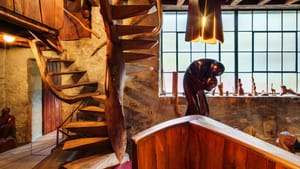Stay in the Loop
BSR publishes on a weekly schedule, with an email newsletter every Wednesday and Thursday morning. There’s no paywall, and subscribing is always free.
Visit the home of a man who truly lived his art

Wharton Esherick (1887-1970) could not pick up a fallen branch, an axe handle that had lost its blade, or an abandoned 2 x 4 without turning it into a work of art that was also useful. As a leader of the movement that turned crafts into art, he made a difference. And you can see and experience the results of this modus vivendi with a tour of his house/studio in the rolling hills of Paoli, Pennsylvania, just beyond Valley Forge National Park.
When Esherick and his wife moved there from Philadelphia in the early 1920s, it was an idyllic rural area, a verdant Garden of Eden that inspired his daily nude peregrinations, weather permitting. Let’s hope he was trim and nimble enough to escape the insects and not destroy the beautiful views.
The house/studio he created is an amazing testament to his skill as an artist. Every architectural detail, piece of furniture, and utensil was made by him and it all works; they’re a delight to touch and fun to experience. During the hour-long guided tours, available by reservation seven days a week, you can marvel at the quality of life envisioned by an artist who, literally, lived his art. His spiral staircase is a major sculpture, beautiful to look at and, fortunately, equipped with a handrail. Drawers in desks, cabinets, chests, and bed frames are fitted with refrigerator lights for instant visibility (I wonder why that useful idea has not been copied commercially). Several pieces of his furniture seem familiar, such as the graceful and distinctive music stands that are on view in many museum collections, including the Metropolitan Museum in New York and the Philadelphia Museum of Art.
Esherick also worked with ceramics, creating pieces that are made for pure pleasure. Note the couple of monkeys hanging from ceiling rafters. Continuing as an artist working in two dimensions, his woodcuts still seem to encapsulate nature’s energy. I am not sure why, but I have some doubts about the utility of copper sinks. And only one thing shocks me: The bathroom was installed in 1947. Any woman might have foregone some of those beautiful serving platters for indoor plumbing. But, I guess, that’s life with an artist.
Born in West Philadelphia, Esherick attended the Pennsylvania Academy of the Fine Arts, studying painting, printmaking, and sculpture. He employed all these techniques throughout his life. Despite that time’s evaluation of woodworking as a craft, not as art, he proved that works of art can be created with wood as well as the traditional marble or plaster. As an artist who turned found objects into works of art, Esherick was a harbinger of today’s art. Like all good artists, he thought outside the box. No wonder the intellectuals of his era sought him out as a special friend.
For group tour reservations or more information, call 610-644-5822, email [email protected], or visit www.whartonesherickmuseum.org.
Sign up for our newsletter
All of the week's new articles, all in one place. Sign up for the free weekly BSR newsletters, and don't miss a conversation.